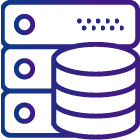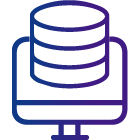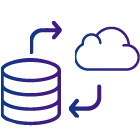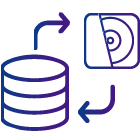Rethink Your Archive and Tiering Strategy
With the massive volumes of data being generated across multiple locations and cloud, data archive and tiering strategies need to be re-thought. Cloud cost models, new threats, and maximizing data value mean new data tools need to be deployed.
Archive & Tiering
Powered by Object Extents
Object extents is a “tar” like format designed for disk and object based archiving. It includes advanced capabilities such as compression, range de-duplication, and acceleration.
Flexible Options – Backup to Disk, Tape or Cloud/Object



Archive/Tier
Disk to Disk

Archive/Tier
Disk to Cloud/Object

Archive
Disk to LTO
FAQ
Which archive sources does DNAfabric support?
DNAfabric can archive from the following sources:
-
- NAS (CIFS, NFS, SMB), SAN, DAS
- Camera Cards, Removable Media
- Public Cloud/Object (AWS S3 – All tiers, Azure Blob – All tiers, Google Cloud Object – All tiers, Wasabi, Backblaze, Seagate LyveCloud)
- Consumer Cloud (Dropbox, Google Drive, Box, OneDrive, Frame.IO)
- Private Cloud/Object (Any S3 compatible storage)
Which archive targets does DNAfabric support?
DNAfabric can backup to the following targets
-
- Public Cloud/Object (AWS S3 – All tiers, Azure Blob – All tiers, Google Cloud Object – All tiers, Wasabi, Backblaze, Seagate LyveCloud)
- Consumer Cloud (Dropbox, Google Drive, Box, OneDrive, Frame.IO)
- Private Cloud/Object (Any S3 compatible storage)
- LTO/LTFS tape
Storage, Cost & Duplication Analysis
How does DNAfabric’s “Storage Analysis” work?
-
- Storage analysis jobs can scan and analyze multiple storage pools across multiple locations. Further, both NAS, file-systems and object stores can be analyzed.
- DNAfabric generates key metrics across every directory including file size, count, distribution by file type, distribution by file age (mod times).
- These results are generated as csv’s which can be further analyzed via Tableau or other BI tools.
How does DNAfabric’s “Duplication Analysis” work?
-
- Duplication analysis jobs can scan and analyze multiple storage pools across multiple locations for duplicate files. Further, both NAS, file-systems and object stores can be analyzed.
- Duplicates are detected based on a full hash or partial hash of the data.
- For file-systems, DNAfabric can optionally create a symbolic linked list view of the data, allowing for duplicate removal in an application of choice.
What cost analysis tools are included for archive and tiering purposes?
-
- DNAfabric include a complete cloud cost analysis toolset. (LEARN MORE HERE)
Deletion & Cleanup
How does DNAfabric’s deletion and cleanup projects work?
-
- DNAfabric can be setup to automatically remove files or object based on policies. This can assist in cleanup across workflow pipelines and space reclamation.
Acceleration & Bulk Ingest
How is data accelerated to object and file-system targets?
-
- DNAfabric employs multiple techniques to accelerate data including multi-threading, multi-processing, multi-part uploads, streaming, packing and compression.
How are bulk ingest/upload devices e.g. AWS Snowcone supported?
-
- DNAfabric supports multiple bulk ingest device across AWS, Azure, Google, Backblaze, Wasabi, LyveCloud and more.
- DNAfabric can perform a LAN based transfer to these ingest devices with a seamless switchover to Internet transfers.
Tiering
How is tiering to multi-tier cloud/object targets supported?
-
- DNAfabric allows you to mix and match tiering with cloud tools and built-in tools. For example, DNAfabric allows a user to set the AWS or Azure tier during upload but also allows you to set the tier once uploaded to cloud.
- In both cases, DNAfabric can resolve the correct tier when downloading the data.
Avid, Adobe & Conform
How does AAF based archive and tiering work?
DNAfabric supports AAF based transfers to any file-system or object target. Instead of directories, AAF files can be specified which are parsed, media files identified and then transferred.
Hoes does Adobe project-based archive and tiering work?
DNAfabric supports Adobe project and production based transfers to any file-system or object target. Instead of directories, proproj files can be specified which are parsed, media files identified and then transferred.
How does ALE-based restores work?
Rather than retrieving files and folders, DNAfabric allows ALEs to be supplied for retrievals. The ALE can be parsed by primary and secondary columns. These columns are used as search terms and identified clips are restored from the target.
Which targets are ALE-based restores supported from?
All supported targets allow for ALE restores.
Compression and De-Duplication (powered by Object Extents)
How is compression supported?
DNAfabric enables compression via Object Extents. Object Extents a modern, tar like format designed for object storage and file-system targets. It can stream multiple files into a single extent while compressing the stream as it writes to the target. It employs zstd to compress the data and based on user provided options multiple files can be streamed into a single extent.
How is de-duplication supported?
In addition to compressing data, multiple files are also de-duped within the same extent. This achieves multiple factors of space savings if similar files exist with repeating data (e.g. multiple project versions, renders, frame based video formats etc.)
HTML Stub Links
What are HTML stub files?
When archiving data, an HTML stub file can be left behind on the source file-system in place of the original file. This allows a user to easily locate the original asset and request a retrieval of the asset if desired.
Which source file-systems and storage systems are supported by HTML stubs?
Stub files can be left behind on any file-system and be optionally enabled on any folder, workspace or Avid/Adobe project archive.
How do stub links work with Avid file-systems?
Normal stubs when left behind in an Avid workspace will get automatically quarantined. DNAfabric creates stubs in a manner that does not cause them to get quarantined.
How do end users initiate retrieves using stub links?
Stubs are simply HTML files left in place of the original. When users can click on the stub, they can click on a link that restore the original file. Optionally, users can retrieve a directory or entire volume.

























